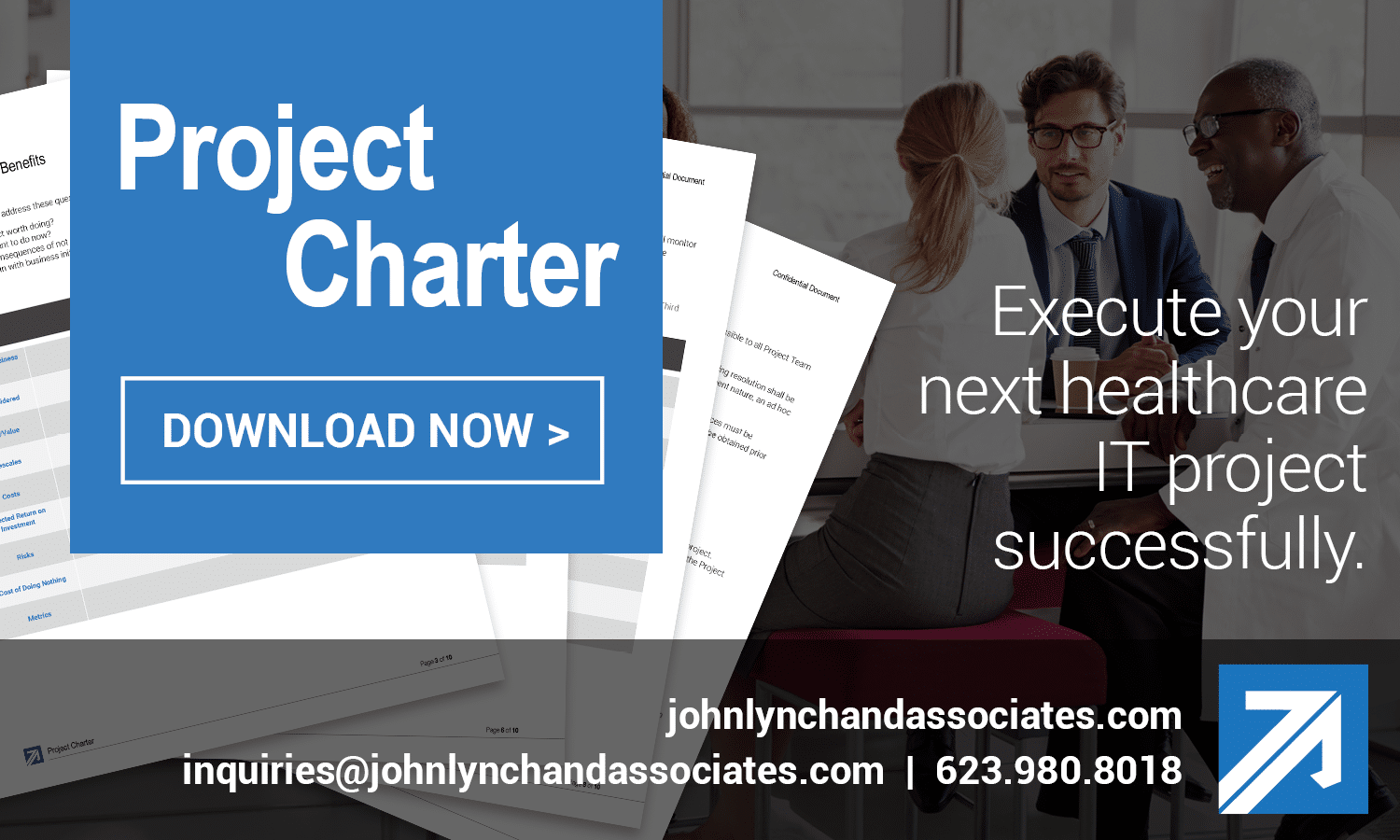Article Highlights
- A project charter is an essential tool that aligns stakeholders, defines scope, and sets expectations from the start.
- Clearly defined goals, responsibilities, and success metrics help prevent scope creep and miscommunication.
- Using a formal charter encourages accountability across teams and keeps the project focused on measurable outcomes.
- A charter facilitates leadership buy-in, ensuring decisions and resource allocation are aligned with organizational strategy.
- The free downloadable template empowers teams to take a structured, repeatable approach to IT project success.
Project Plan Development
Managing a transformative project for an organization is both challenging and rewarding. As consultants, we are frequently asked by clients what our secret is to successful project implementation. Our secret is in the planning.
Companies throughout the healthcare industry, whether small or large, are familiar with project charters and project plans. A project charter is the overall guide to the details of the project and the plan is the backbone of any undertaking.
However, one of the things that we consistently see at client sites is that organizations are using dated tools such as spreadsheets or a program list full of detailed tasks.
While these are necessary components, they do not go far enough to ensure that a specific project or groups of projects are fully realized, planned, and meaningful to the organization.
The traditional project plan, that most organizations use, satisfies the who, what, and where of a particular project and aids in tracking and managing tasks, budget, milestones, and deliverables.
All of these are crucial factors to the success of any project. However, we use our John Lynch & Associates’ Comprehensive Project Charter which goes beyond the traditional measures to include areas that:
- Ensure alignment with organizational goals and values
- Focus on Executive-level agreement and collaboration
- Level-set benchmarks and key performance indicators (KPIs)
- Proactively identify and manage risks
- Evaluate communication strategies
- Focus on evidenced-based Change Management strategies
A comprehensive project charter allows your project managers and teams to prepare for every aspect of a transformative project.
Furthermore, giving your project leaders the tools and time that they need to proactively manage and mitigate any potential disruptions or roadblocks significantly increases the chances of a successful and effective project. For your convenience, we have provided a simplified version of our project charter below.

Documentation, Testing, and Reporting
Implement a quality documentation system that every project team member is trained in. Team members should know exactly why, when, and how each part of the project is being implemented.
Verify the overall results of the project and that the system functionality performs at the expected level. Testing ensures team members have done their job well and the implementation was successful.
Whether your project is small enough to be handled by one project manager or you have a team of four to five managers working together, there should be a consistent system of biweekly reporting to ensure that enough progress is being made between reports to build momentum and emotional buy-in from the team, while being frequent enough to allow for course corrections as needed.
Completion, Evaluation, and Control Strategies
Finally, the project will come to completion. During this time, you will need to measure your key performance indicators (KPIs) in the context of the baselines that were established at the start of the project.
Also, evaluate the success of your IT project by addressing questions such as:
- What did you do well?
- What could we have done better?
- Did we make the right decisions?
- How do we do better next time?
Identify the strengths, weaknesses, and accurate timelines so that next time your organization needs to execute a similar plan, you will be better equipped to do so. Create an open forum where trust is established, and project participants feel safe in expressing their opinions.
The focus of the evaluation process should be a collaboration on improving on mistakes and duplicating successes for future projects.
Lastly, reinforce the strength of your organizational systems by implementing control strategies. For example, set a recurring appointment with your team to evaluate your operations to identify any areas that need to be reinforced.
Then, implement training for new skills, re-train employees on existing work requirements, and consistently evaluate workflows, which naturally evolve over time.

High Rate of Failure
The failure rate of healthcare IT projects is staggeringly high. Many contributing factors that lead to healthcare IT project failures include:
- Utilizing untrained internal resources for project management
- Lack of carefully planned goals and objectives
- Changing objectives
- Shortage of executive support and involvement
- Poor team communication
Failure to successfully implement a project comes at great cost for a healthcare organization including:
- Low reimbursement success rate
- Staff attrition
- Physician & staff frustration
- Legal ramifications
- Miscommunication between team members, patients, and stakeholders
- A stained reputation within the healthcare industry
Unfortunately, these negative outcomes often trickle down to the patient in the form of longer patient wait times, dissatisfaction, failure to receive adequate information, and overall inadequate quality of care.
A more prudent strategy would be to keep your valuable internal team in their current positions and bring in external help for the short-term project of implementing a new solution and training staff members on how to use the new system to its fullest potential.
Do The Job Right – Once
We have seen first-hand how implementing a clinical solution from a strategic, expert level has helped our clients. Some of the most common outcomes include:
- Obtaining more thorough and complete patient information
- Maintaining accurate patient health records
- Improving accuracy in diagnosis and procedure codes
- Processing more accurate claims and billing processes
- Improving reimbursement
- Increasing physician and staff morale
- Improving a sense of teamwork and collaboration
- Stronger and more efficient communication
One of the most rewarding benefits we help our clients achieve is establishing a system that allows physicians, PAs, and clinicians to practice to the top of their licenses. In other words, we help each staff member work to the top of his or her ability and credentials, which creates greater efficiency within the entire organizational ecosystem.
For example, if a physician is doing work that a PA or administrator can do, then that physician is not making the best use of his or her time. With front office staff working to the top of their credentials, and nurses and PAs doing the same, this takes a significant burden off physicians and frees up valuable time and energy that can be allocated to improved quality of patient care.
Conclusion
While it may be difficult to envision how something as technical as executing an IT clinical solution successfully can affect something as personal as the quality-of-care patients receive, the connection runs deep.
The IT systems we rely on every day allow us to serve patients better, more efficiently, and with greater dedication, which is precisely why John Lynch & Associates' expert project managers are dedicated to advancing healthcare through consulting excellence.
Implementing a healthcare IT project of any size is challenging and the cost of a project executed successfully the first time far outweighs the cost of a failed one. If you are preparing to start a healthcare IT project, connect with a connect with a project manager, we are here for you and happy to help.
Ready to Talk?
Related Articles

What Does a Healthcare Project Manager Do?

How a Healthcare IT Consultant Adds Value to Your Organization


